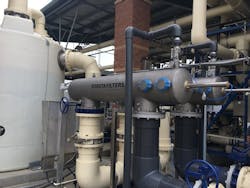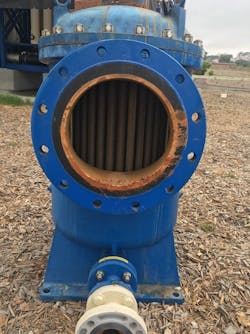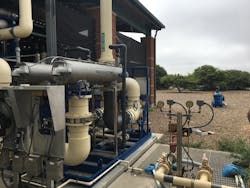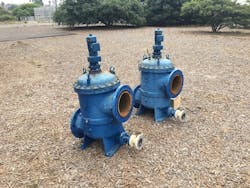About the author:
Polly Stenberg is director of sales for Forsta Filters Inc. Stenberg can be reached at
[email protected].
The Encina Wastewater Authority (EWA) is a public agency located in Carlsbad, Calif. It provides wastewater treatment services to more than 400,000 residents in northwestern San Diego County. EWA’s facilities and services are essential for protecting the local ocean environment, preserving public health and providing valuable water resources for the region.
EWA is owned by six public agencies governed by a Joint Powers Agreement. Under this agreement, the owners share in the operational and management costs of EWA with an objective to cooperatively fund economical and high-tech facilities. The six owners are: the city of Carlsbad, city of Vista, city of Encinitas, Vallecitos Water District, Buena Sanitation District and Leucadia Wastewater District.
Founded in 1961, EWA operates and maintains the Encina Joint Sewerage System, which includes the Encina Water Pollution Control Facility, the Encina Ocean Outfall, the Agua Hedionda and Buena Vista Pump Stations.
EWA also manages and operates other regional water recycling and pumping facilities for its owners, including the Carlsbad Water Reclamation Facility, Buena Creek Pump Station and Raceway Basin Pump Station. The EWA System represents a significant infrastructure investment. Since 1980, the members of the Joint Powers Authority have invested more than $600 million to protect the economy and quality of life for North County residents and businesses.
In Sept. 2016, EWA commissioned a new 3.38-million-gal-per-day (mgd) recycled water system. The new system would process secondary effluent through an ultrafiltration (UF) membrane system at the Carlsbad Water Reclamation Facility and provide the treated effluent from the facility for local irrigation and land application. Local golf-courses, parks and landscapes would no longer need to rely on potable water for irrigation.
According to the city of Carlsbad, each gallon of recycled water that is used to irrigate parks, street medians, freeway landscaping and golf courses saves a gallon of drinking water. A gallon of recycled water also is approximately 16% cheaper than a gallon of potable water because the city controls the production.
Carlsbad has approximately 79 miles of recycled distribution pipeline that currently supplies more than 700 recycled points of connection.
New System Design & Commissioning
The new recycled water and UF membrane system was designed with 200-µ mesh pre-strainers for protection of the UF membranes. Prefiltration ahead of the UF membranes prolongs the life of the system by protecting them from an excess of suspended solids.
The pre-strainers selected for the Carlsbad job had multiple mesh wire candles and would theoretically utilize a fluid reversal mechanism for automatic backwashing. Within two weeks of the completion of the system commissioning, the pre-strainers presented operational problems. The fluid reversal mechanism that was intended to clean the strainer screens did not relieve the accumulated differential pressure. The strainers had to be disassembled at that time for inspection and manual cleaning.
Disassembly of the units required a cherry picker forklift and a complete system shutdown. From start to finish, the maintenance intervention took approximately three hours. Review of the strainers’ multiple candle elements showed that the flow reversal technology was not sufficient to remove the sticky debris that characterized the plant’s secondary effluent.
Once disassembled, the strainer candles had to be individually power-washed to resume system operation.
After the first power-wash intervention, the strainers became ineffective within a few days, differential pressure was not relieved, and the three-hour system shutdown and manual intervention had to be repeated. The pattern continued and required that the commissioning original equipment manufacturer (OEM) provide manual cleaning twice per week.
In November, the strainer representative was brought onsite to conduct an installation review. During the visit, the rep indicated that the mechanical function of the equipment was intact, and the faulty cleaning in the installation had to do with chemistry. The strainer company provided no further support, indicating that issues of chemistry were beyond the scope of its work.
An immediate consequence of the malfunctioning strainers was that overall system flow had to be dropped to 66% of normal flow. If not for this imposed flow reduction, the manual power-wash intervention would have been required daily. The ongoing consequence amounted to about one day per week of manual service, at a cost of approximately $1,200 per day, for a period of nine months. The cumulative cost of troubleshooting fell to the OEM and essentially eliminated the value of the project.
Problem Solving
By Jan. 2017, plans were set in motion to run a pilot for replacement equipment to finally succeed the failed strainers. EWA needed a lasting solution to the equipment failure of the strainers.
In February at the 2017 AWWA Membrane Technology Assn. conference in Long Beach, Calif., the OEM responsible for the Carlsbad UF system became acquainted with Forsta technology. Forsta Filters engineers learned of the problems encountered at the Carlsbad facility and were confident they could provide equipment that would hold up to the operating conditions and provide reliable long-term service.
After consultation, the OEM brought on Forsta to assist in conducting a three-month pilot system to verify the efficacy of Forsta’s design to solve the problems encountered with the strainers. The city wanted reliable pilot results before approving selection of replacement equipment. The sticky material that had clung to the original strainer candle elements was of particular concern.
The pilot, which began in April 2017, was designed to handle approximately 100 gpm of the secondary effluent with a 200-μ mesh screen. Pilot data included time for the filter to accumulate differential pressure, number of total backwashes in a given period and the ability of the backwash to fully relieve differential pressure.
Three months of backwash monitoring validated Forsta’s design and technology for the scaled-up version. During the pilot monitoring period, differential pressure was consistently relieved by the automatic backwash sequence, and suction scanning reliably removed all visible debris for about 800 consecutive backwashes.
One other technology was under consideration during the pilot phase. It was rejected due to lack of performance during the pilot, painted carbon steel construction versus the stainless construction of the Forsta model, and lengthy lead times resulting from overseas manufacturing.
Installation and start-up were conducted with the full-scale Forsta suction scanners in July 2017. Forsta spent the next few months monitoring the installation closely with the OEM and onsite operations staff. This design theory allows any technical issues that arise to be addressed in an efficient and methodical manner. Based on the performance of the pilot, engineers knew that once optimized to the conditions, the full-scale units would solve the crippling issues of the previously failed strainers.
The secondary clarifiers that feed the trains to the UF system at the Carlsbad facility are open to the air, and as such accumulate debris from the marine environment. The marine debris and the treatment minerals used in the process stream caused some unforeseen issues with the scaled-up cleaning mechanism and piston interface.
When the issues presented themselves, Forsta provided the OEM with a hands-on material adjustment phase as part of the standard installation optimization protocol.
In order to ensure proper and consistent piston function, engineers introduced a glycol dispenser tank to consistently lubricate the movement of the piston and guarantee that treatment chemicals would not disrupt the mechanical operation of the filters.
After the final material adjustments were made to the full-scale installation, equipment was monitored for a 30-day trial period starting Oct. 2, 2017. During the trial period, the strainers demonstrated a greater than 98% recovery and a consistent backwash interval approximately once every 45 mins. The cleaning mechanism reliably relieved the differential pressure.
Based on successful operation over a 30-day period, the operators were able to establish a once-per-month routine check of glycol levels on the piston tanks. The strainers passed the 30-day performance test, and equipment has performed consistently. The UF system has functioned at 100% flow capacity, and the strainer replacement project has been deemed a success by the OEM and the city of Carlsbad.



